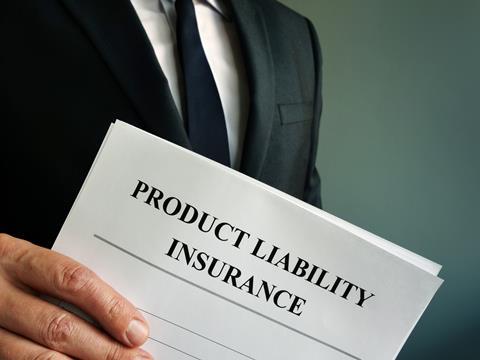Small and medium-sized enterprises are particularly vulnerable to product liability threats. Captive solutions may hold the answer, argues Randy Sadler, CIC Services
In an age of rapid globalisation and heightened consumer awareness, product liability risks loom large, posing significant challenges to businesses.
While massive conglomerates may have the financial reserves to weather substantial legal damages, small and medium-sized enterprises (SMEs) stand perilously close to the edge, often with less cushioning against severe financial storms.

Recognising this vulnerability, it becomes paramount to delve into tailored insurance solutions.
The SME liability landscape
The business world is replete with cautionary tales highlighting the perils of underpreparedness.
Peanut Corporation of America (PCA)
Located in the heart of Georgia, PCA was a critical supplier to many snack food manufacturers.
When a salmonella outbreak traced back to their facilities, it wasn’t just a health crisis; it unveiled a chain of negligence.
Lack of internal checks, poor facility maintenance, and evidence suggesting the company knowingly shipped contaminated products intensified the situation.
The subsequent litigation, accompanied by severe reputation damage, made their previous $25 million annual revenue seem minuscule compared to the financial and societal costs incurred.
The brand trust was irrevocably damaged, and major clients severed ties. The tragedy wasn’t just the illness spread but the evident lack of risk preparedness both in operation and insurance.
Maxfield & Oberton’s Buckyballs
Buckyballs, created and imported from China by Maxfield & Oberton, were designed as magnetic desk toys for adults.
Their marketing was clear about the intended user demographic, and they consistently worked with the Consumer Product Safety Commission (CPSC) to ensure all safety labeling met standards.
Over the years, they revamped their labels multiple times, accommodating more stringent safety regulations. Yet, despite these proactive measures, they found themselves under federal scrutiny.
The CPSC’s issue was with isolated incidents where children ingested the magnetic balls, leading to severe health complications. These 20 cases, over a backdrop of 3 million products sold, propelled CPSC to demand a recall.
Maxfield & Oberon’s staunch defense of their product couldn’t prevent the ensuing commercial fallout. Major retailers removed Buckyballs from their shelves, and eventually, production was halted.
The incident underscores that even meticulous safety precautions may not shield companies from liability challenges.
Both the PCA and Maxfield & Oberton cases underscore the precarious landscape of product liability for SMEs.
While PCA’s downfall stemmed from internal negligence and insufficient risk management, Maxfield & Oberton faced challenges despite adhering to regulatory standards.
Together, these instances highlight the multifaceted vulnerabilities SMEs navigate in the realm of product liability, emphasising the importance of comprehensive protective measures.
The inherent gaps in traditional insurance
Modern businesses operate in an intricate web, defined by vast global supply chains, making them vulnerable to a range of unforeseen risks.
With evolving technologies and standards, risk assessment is a moving target, often outpacing traditional insurance models. These models, with their myriad of complexities, frequently offer limited clarity on pricing.
Moreover, indirect consequences like reputational hits or diminishing customer trust, amplify the operational challenges, straining SMEs’ limited financial infrastructures.
The role of captives
Captive insurance, though not a new entrant in the insurance sector, is becoming increasingly relevant.
It’s a specialised form of self-insurance where companies create a wholly-owned subsidiary, solely to provide their insurance coverage.
It represents a strategic pivot, allowing businesses to assert more control over risk management. As the demand for bespoke solutions grows, captive insurance presents itself as an evolved, responsive model.
The advantages of captive insurance for SMEs
- Holistic recall coverage: Product recalls are multifaceted challenges. While the direct costs are palpable, the indirect ramifications can be equally, if not more, daunting. Mainstream insurance, with its standardised offerings, often struggles to provide holistic coverage. In contrast, captive insurance’s proactive, customisable nature delivers comprehensive solutions tailored to specific recall challenges.
- Claims management: The ability to manage and resolve claims efficiently and effectively is crucial. Captive insurance offers businesses a hands-on approach, ensuring swift resolutions in sync with the company’s values and long-term vision.
- Harnessing collective strength: Captive insurance, especially in group structures, epitomises collective fortitude. Businesses converge, sharing not just financial burdens but also vital insights. This collaborative essence engenders continual refinement, fostering a culture of safety and proactive liability prevention.
- Fiscal stability in a sea of change: Traditional insurance premiums can be unpredictable, creating budgetary challenges. Captive insurance, being insulated from broad market dynamics, offers a refreshing stability, ensuring predictable costs and better fiscal planning.
A standout facet of captive insurance lies in its financial structuring. Premiums paid into the captive, after accounting for claims, are effectively retained profits.
This accumulation becomes a strategic reserve. In unforeseen crisis scenarios, these funds offer a lifeline, acting as a buffer against severe financial strain. It’s a twofold win: businesses get insurance coverage while also building a financial safety net.
Premiums paid aren’t just for coverage; they’re an investment. Funneled into the captive entity, these funds, after accounting for claims, become profits.
This model introduces a dual advantage: robust coverage and a reserve fund. This reserve is essential, providing businesses with resources to navigate challenges, from unforeseen liabilities to managing reputation recovery costs.
The evolving nature of business, marked by technological advances, changing regulations and heightened consumer expectations, demands adaptive strategies. Passive approaches are no longer viable.
For businesses, especially SMEs, navigating the treacherous terrains of product liability, captive insurance offers a beacon of hope, charting a path towards resilience and sustainable success.
About the author:
Randy Sadler started his career in risk management as an officer in the U.S. Army, where he was responsible for the training and safety of hundreds of soldiers and over 150 wheeled and tracked vehicles. He graduated from the U.S. Military Academy at West Point with a Bachelor of Science degree in International and Strategic History with a focus on U.S. – Chinese Relations in the 20th century. He has been a principal with CIC Services, LLC for 7 years and consults directly with business owners, CEOs and CFOs in the formation of captive insurance programs for their respective businesses.














No comments yet